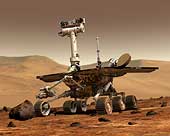|

Primary among the mission's scientific goals is to search for and characterize a wide range of rocks and soils that hold clues to past water activity on Mars. The spacecraft are targeted to sites on opposite sides of Mars that appear to have been affected by liquid water in the past. The landing sites are at Gusev Crater, a possible former lake in a giant impact crater, and Meridiani Planum, where mineral deposits (hematite) suggest Mars had a wet past. After the airbag-protected landing craft settle onto the surface and open, the rovers roll out to take panoramic images. These will give scientists the information they need to select promising geological targets that will tell part of the story of water in Mars' past. Then, the rovers will drive to those locations to perform on-site scientific investigations over the course of their 90-day mission. Press Releases |
